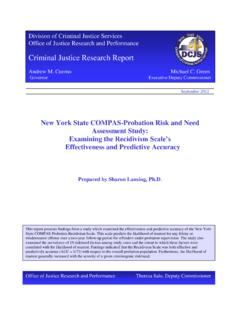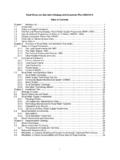Transcription of Practitioners Guide to COMPAS - Northpointe, Inc.
1 Practitioners Guide to COMPASA ugust 17, 2012 ContentsTable of Contentsi1 History and Development .. for Practitioners ..22 Case .. the COMPAS Score .. of Interpretation .. Theories .. Learning Theory: .. Theory: .. Theory: .. Breakdown Theory: .. Opportunity Theory (including Routine Activity): .. Descriptive Information for the Scales .. of Raw Scale Scores to Decile Scores .. Decile Scores .. Groups and Scale Distributions ..133 COMPAS Validity and Validity .. of COMPAS Needs Scales .. Validity .. Validity .. Consistency Reliability .. Reliability ..224 Treatment Implications for Scales .. Release Risk .. Recidivism .. Recidivism .. Counter-Intuitive Predictions.
2 Need Scales .. Behavioral .. Associates/Peers .. Involvement .. Opportunity .. Personality .. Thinking Self-Report .. Violence .. Criminality .. Problems .. History of Non-Compliance .. History of Violence .. Leisure/Boredom .. Residential Instability .. Social Adjustment .. Social Environment .. Social Isolation .. Socialization Failure .. Substance Abuse .. Vocation/Education .. The Lie Scale and Random Responding Test ..425 .. Typology .. Descriptions .. Typology .. Descriptions ..52 Bibliography55 2011 Northpointe Inc., All Rights 1 IntroductionCOMPAS is a fourth generation risk and needs assessment instrument. It is a web-basedtool designed to assess offenders criminogenic needs and risk of recidivism.
3 Criminal jus-tice agencies across the nation use COMPAS to inform decisions regarding the placement,supervision and case management of offenders. Empirically developed, COMPAS focuses onpredictors known to affect recidivism. It includes dynamic risk factors in its prediction ofrecidivism, and it provides information on a variety of well validated risk and needs factorsdesigned to aid in correctional intervention to decrease the likelihood that offenders has two primary risk models: General Recidivism Risk and Violent RecidivismRisk. COMPAS has scales that measure both dynamic risk (criminogenic factors) and staticrisk (historical factors).Statistically based risk/needs assessments have become accepted as established and validmethods for organizing much of the critical information relevant for managing offendersin correctional settings (Quinsey, Harris, Rice, & Cormier, 1998).
4 Many research stud-ies have concluded that objective statistical assessments are, in fact, superior to humanjudgment (Grove, Zald, Lebow, Snitz, & Nelson, 2000; Swets, Dawes, & Monahan, 2000). COMPAS is a statistically based risk assessment specifically developed to assess many of thekey risk and needs factors in adult correctional populations and to provide decision-supportinformation regarding placement of offenders in the community. It aims to achieve thesegoals by providing valid measurement and succinct organization of many of the salient andrelevant risk/need dimensions. Northpointe recognizes the reality of case management con-siderations and supports the use of professional judgment in concert with actuarial risk/needsassessment.
5 Following assessment, a further goal is to help Practitioners with case plan de-velopment/implementation and overall case management overloaded and crowded criminal justice systems, brevity, efficiency, ease of administrationand clear organization of key risk/needs data are critical. COMPAS was designed to optimizethese practical factors. We acknowledge the trade-off between comprehensive coverage of keyrisk and criminogenic factors on the one hand, and brevity and practicality on the deals with this trade-off in several was; it provides a comprehensive set of keyrisk factors that have emerged from the last decade of criminological literature, and it allows12for customization inside the software. Therefore, ease of use, efficient and effective timemanagement, and case management considerations that are critical to best practice in thecriminal justice field can be achieved through COMPAS History and DevelopmentCOMPAS was first developed in 1998 and has been revised over the years as new informationin the criminal justice field has emerged toward best practice use and intervention.
6 Theupdated normative data were sampled from over 30,000 COMPAS assessments conductedbetween January 2004 and November 2005 at prison, parole, jail and probation sites acrossthe United States. The latest revision used the same groups, but in actual proportion tothe numbers of offenders found in each group in the criminal justice system (no groupswere overrepresented). COMPAS allows for selection of reference groups for the agency, prison norm set, however, there is also a composite norm set based on the continuumdescribed Overview for PractitionersThis section is intended to provide users of COMPAS Core with a meaningful and practicalunderstanding of each scale incorporated into the assessment.
7 COMPAS Core is comprisedof a total of forty-one scales, including four higher order scales ( , scales that use itemsfrom other scales that crosscut several domains) and sixteen women specific need scale included in the COMPAS Core assessment is listed below with an explanation ofthe themes and constructs measured, the treatment implications for high scores on the scale,and a listing of the items or questions in the assessment that are used to score the COMPAS Core assessment is designed to be configurable for the user at various decisionpoints within the local criminal justice system and with various populations ( , women,men, institutional, community). Users may choose scale sets (or groups of scales) relevantto their needs for assessing a person at various stages of the criminal justice process.
8 Forexample, Pre-trial Services may choose to use only the Failure-to-Appear scales to make rec-ommendations to the court regarding pre-trial release. Probation may then use the Violenceand Recidivism scales to triage their caseloads by risk of re-offense and violence, and chooseto only complete the full assessment ( , all scales) on those individuals scoring moderate orhigh risk to gain a holistic view of the person in order to appropriately address supervisionand treatment needs for rehabilitation. In addition, there are need scales available that arevalidated specifically for women, so scale sets can be configured for men or options make cross-referencing by item number difficult because each time ascale set is altered the item number for each question changes.
9 For this reason, item numbersare not used to identify items from the questionnaire for each scale in the following the user creates a scale set with only select scales for an assessment, the same items willbe used to compute the score for the scale, but the item numbers for each item might vary. 2011 Northpointe Inc., All Rights COMPAS software has undergone periodic updates and changes, and will continue togrow with emerging and best practice discoveries, as well as technological to specific functions or questionnaire numbers are not made in this document dueto the ongoing changes and customizations that exist in the applications. Software manualsexist on theHelptab on every Northpointe client s Core was developed to be used with criminal justice clients at any point duringtheir supervision and can be used as a reassessment tool.
10 The Case Supervision Reviewscreening (23 items) has been built into all COMPAS sites as an optional method for periodicreview of the person s status and progress. 2011 Northpointe Inc., All Rights 2 Case InterpretationThis chapter gives an introduction to the interpretation of a Core COMPAS computing an assessment in the COMPAS software the practitioner will generallyinterpret the bar-chart displaying decile scores (explained in detail below) and the typeassigned by the typology (if enabled by the site). The bar-chart indicates in what areasthe person scores higher or lower, , which risks or criminogenic needs may exist. Theimplications for treatment and intervention are discussed in chapter 4.











